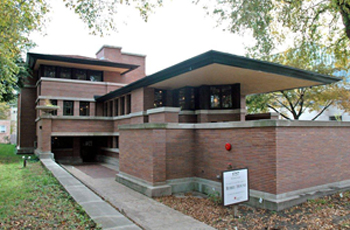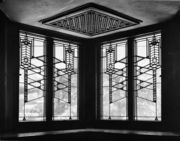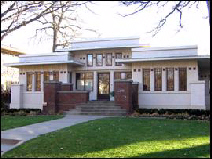The Prairie Style
The Prairie School was the United States' only indigenous architectural style. Developed in the Midwest, it was a rebellion against the Victorian and neo-Classical architecture popular at the time. It was made famous through Frank Lloyd Wright in 1901 with his plan published in Ladies Home Journal titled "A Home in Prairie Town."
Prairie-style houses were ahead of their time and still seem modern; they featured horizontal lines, flat or hipped roofs with broad overhanging eaves, and horizontal rows of windows, often art glass in geometric patterns. The emphasis on the horizontal represented the wide prairie landscape.
Inside, the houses typically had a central chimney and an open floor plan, very different from Victorian homes with their many small and separate rooms. The Prairie School, like the Arts and Crafts movement it was related to, supported the creation of well-made, beautiful, and unified furniture and architecture. Wright did not simply design a house, he created an environment, with stained glass, fabrics, and other items, and he often built furniture into the house.

The Balch House in Oak Park, Illinois, was designed by Frank Lloyd Wright in 1911.
Frank Delos Wolfe may have been initially attracted to the Prairie school because of his own midwestern roots, but he had a deep interest in different architectural trends and freely mixed styles he liked, as his "California Prairies" showed. Wolfe took inspiration from all the Prairie School architects, most notably Frank Lloyd Wright and Henry Charles Trost, and he also made liberal use of neoclassical details, especially in the decorative moldings that adorn the large Prairie residences. He also added his own signature touches, such as enormous plate glass windows, and "pendent tiles," large decorative tiles that appear to be hanging from under the eaves.

Frank Lloyd Wright designed the Robie House in 1908.

Windows in the Robie House. Frank Wolfe was inspired by Wright's use of art glass.
The best-known of Wolfe’s Prairie designs is the house built for Peter and Blanche Col in San Jose's Hanchett Park neighborhood. There are several variations on this residence in the San Jose area.
One of the things that makes the Col House and its counterparts so striking is their broad facades and the amount of land they occupy. These are one-story residences with a huge footprint; each is over 2500 square feet and with their frontage, they require more land than the typical house. Some of them were built in what were then country settings; those in the residential neighborhoods requred double or even triple lots. San Jose's Naglee Park, Hanchett Park, and Palm Haven were planned neighborhoods with limited lot sizes. Wolfe & Wolfe built a number of smaller Prairie homes that sat sideways on narrower lot within these neighborhoods.
Click here for an extensive list of Prairies in San Jose.

